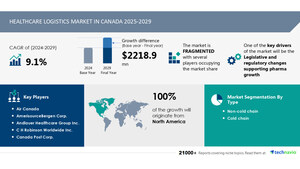NEW YORK, March 25, 2024 /PRNewswire/ -- The global deep sea robot market size is estimated to grow by USD 2092.15 mn from 2024-2028, according to Technavio. The market is estimated to grow at a CAGR of 12.05% during the forecast period. The deep sea robot market is experiencing significant growth due to increasing oceanography research, driven by climate change concerns and rising sea levels. Key applications include underwater surveillance, oil & gas sector exploration, and defense & security. Robots feature autonomous navigation, environmental perception, and self-maintenance, utilizing AI software and submersibles. Demand also comes from commercial exploration and deep-sea research using torpedoes and submersibles.
For more insights on the historic (2018 - 2022) and forecast market size- Request a sample report
Deep Sea Robot Market Scope |
|
Report Coverage |
Details |
Base year |
2023 |
Historic period |
2018 - 2022 |
Forecast period |
2024-2028 |
Growth momentum & CAGR |
Accelerate at a CAGR of 12.05% |
Market growth 2024-2028 |
USD 2092.15 million |
Market structure |
Fragmented |
YoY growth 2022-2023 (%) |
10.78 |
Regional analysis |
North America, Europe, APAC, Middle East and Africa, and South America |
Performing market contribution |
North America at 35% |
Key countries |
US, Canada, China, Germany, and Norway |
Key companies profiled |
BAE Systems Plc, Blue Robotics Inc., CRRC Corp. Ltd., Deep Ocean Engineering Inc., DOER Marine, Exail Technologies, Forum Energy Technologies Inc., Halma Plc, International Submarine Engineering Ltd., Kongsberg Gruppen ASA, L3Harris Technologies Inc., Lockheed Martin Corp., Mariscope, Nauticus Robotics Inc., Oceaneering International Inc., ROVOP Ltd., Saab AB, Shark Marine Technologies Inc., TechnipFMC plc, and VideoRay LLC |
Segment Overview
This deep sea robot market report extensively covers market segmentation by Type (ROV, AUV, Submersible vehicles) Application (Commercial exploration, Defense and security, Scientific research) Geography (North America, Europe, APAC, Middle East and Africa, South America)
Market segmentation by Type
The Deep Sea Robot Market is experiencing significant growth, driven primarily by the commercial exploration sector. This segment encompasses submarine mining and oil and gas exploration. The ocean floor is estimated to hold vast untapped resources and minerals, leading to increasing demand. Deep-sea robots are essential for oil and gas exploration, contributing to market expansion. Submarine mining is a notable sub-segment, focusing on extracting minerals like zinc, nickel, copper, and cobalt from the seabed.
Geography Overview
The Deep Sea Robot Market in North America is experiencing substantial growth, fueled by the expanding demand in sectors like oil and gas, defense, and research. Notable players and supportive government initiatives contribute to this market's robust expansion. A significant factor driving growth is the increasing demand from the oil and gas industry, with major companies investing heavily in deep sea robots for exploration and production activities.
Insights on the market contribution of various segments including country and region wise, historic (2018 - 2022) and forecast market size- Download a Sample Report
- The deep sea robot market is experiencing significant growth due to the increasing demand for underwater surveillance in the oil & gas sector. Advanced robotics, including submersibles and exploration robots, navigate ocean depths to inspect and maintain pipelines and platforms. Equipped with AI software and NDT technologies, these robots detect anomalies, conduct autonomous non-destructive testing, and enhance environmental perception for commercial exploration and defense applications.
- The deep sea robot market has experienced robust growth due to the surge in demand for underwater surveillance and exploration in challenging offshore oil and gas locations. Robots, including submersibles and autonomous underwater exploration vehicles, are essential for performing tasks in extreme ocean depths. These advanced machines offer self-maintenance, environmental perception, autonomous navigation, and are used in commercial exploration, defence and security applications. Deep-sea robots incorporate AI software and are equipped with advanced features like self-diagnostics and autonomous decision-making.
Insights on Market Drivers, trends, & Challenges, historic period(2018 - 2022) and forecast period(2024-2028)- Request a sample report!
Research Analysis
The Deep Sea Robot Market is experiencing significant growth due to the increasing demand for underwater surveillance and exploration in various sectors, including oil and gas. Advanced underwater exploration robots, such as submersibles and cube-like structures equipped with propellers, cameras, manipulator's arms, and sonar systems, are being utilized to explore ocean depths for shipwrecks and oil reserves. These robots are also essential for anti-submarine warfare, employing torpedoes and sonar pulses to detect electromagnetic waves and sound waves in seawater. BAE Systems is a leading player in this market, developing innovative technologies like Free-Space Optical (FSO) for underwater communication and imaging. However, surface ambient noise and encounters with marine life, such as eels, pose challenges to the effective operation of these robots.
Market Research Overview
The Deep Sea Robot Market is experiencing significant growth due to the increasing demand for exploration and resource extraction in the ocean depths. These advanced technologies, such as Propellers, Ships, Structures, Cubesats, Membranes, Cameras, Manipulators, and Sonar, play a crucial role in deep sea robotics. The use of Crews, Membranes, and Robotics in oil and gas exploration, as well as in research and military applications, is driving market expansion. Furthermore, the development of Varasts and Equinor's Nyholm XL base in Norway, which will serve as a hub for deep-sea robotics, is expected to boost the market. The market is projected to reach new heights with the implementation of advanced technologies like Boomers, Planes, and Nauticus ROVs. The market's size and revenue are expected to increase significantly in the coming years.
Table of Contents:
1 Executive Summary
2 Market Landscape
3 Market Sizing
4 Historic Market Size
5 Five Forces Analysis
6 Market Segmentation by Product Type
7 Market Segmentation by Distribution Channel
8 Customer Landscape
9 Geographic Landscape
10 Drivers, Challenges, and Trends
11 Company Landscape
12 Company Analysis
13 Appendix
About Technavio
Technavio is a leading global technology research and advisory company. Their research and analysis focuses on emerging market trends and provides actionable insights to help businesses identify market opportunities and develop effective strategies to optimize their market positions.
With over 500 specialized analysts, Technavio's report library consists of more than 17,000 reports and counting, covering 800 technologies, spanning across 50 countries. Their client base consists of enterprises of all sizes, including more than 100 Fortune 500 companies. This growing client base relies on Technavio's comprehensive coverage, extensive research, and actionable market insights to identify opportunities in existing and potential markets and assess their competitive positions within changing market scenarios.
Contacts
Technavio Research
Jesse Maida
Media & Marketing Executive
US: +1 844 364 1100
UK: +44 203 893 3200
Email: [email protected]
Website: www.technavio.com/
SOURCE Technavio

WANT YOUR COMPANY'S NEWS FEATURED ON PRNEWSWIRE.COM?
Newsrooms &
Influencers
Digital Media
Outlets
Journalists
Opted In




Share this article